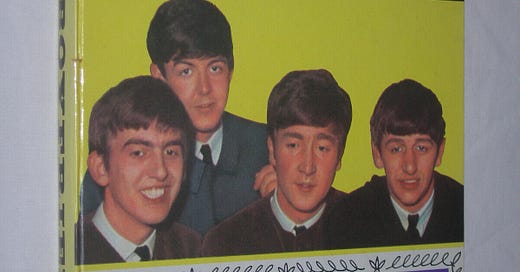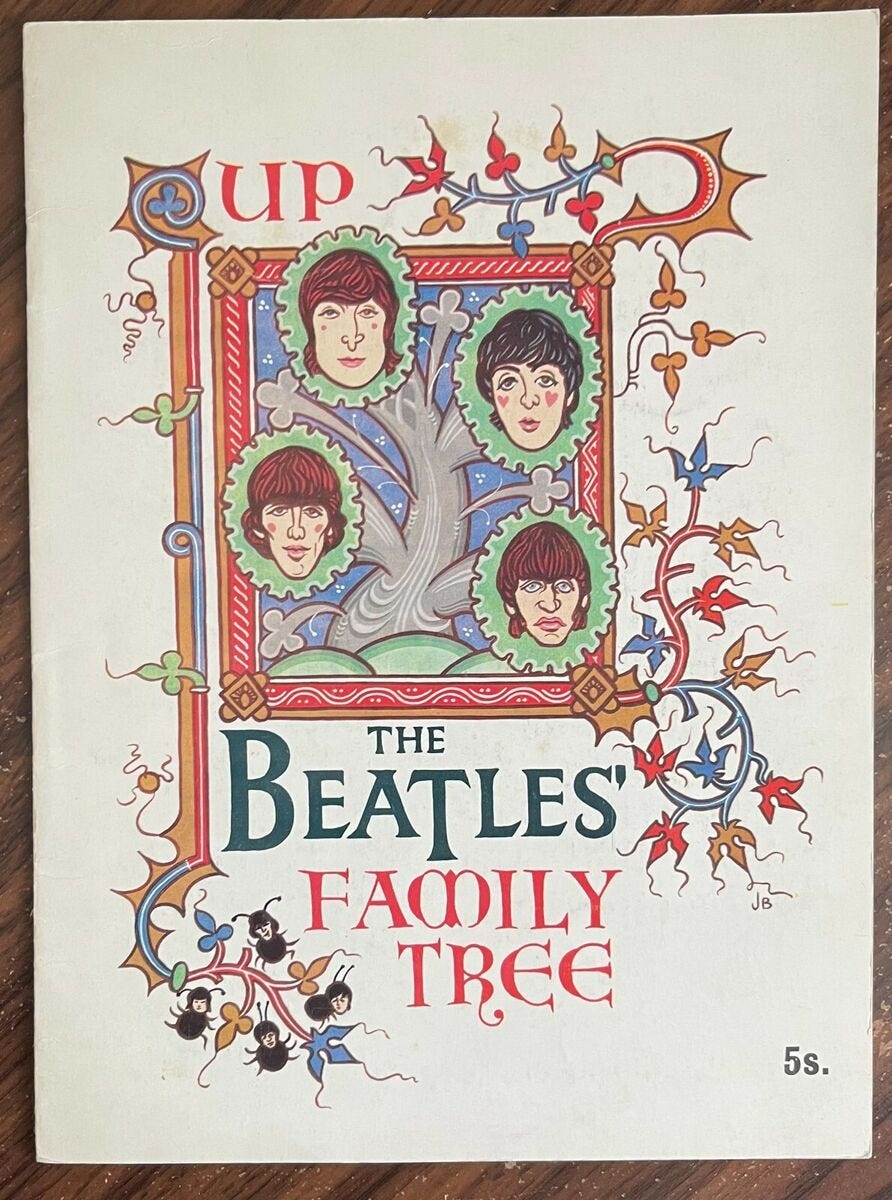Introduction: Getting Better All The Time
Hello there, dear readers! It's been a long and winding road through the many tomes written about our beloved Fab Four, hasn't it? Today, I'm taking you on a magical mystery tour through two rather curious Beatles books that couldn't be more different if they tried: "Boyfriend 65 - Proprietors City" and "Up The Beatles' Family Tree." One's a swinging sixties teen magazine special, and the other's a proper genealogical exploration. Let me tell you, both books are real nowhere men in the Beatles literature landscape—peculiar little oddities that help us eight days a week to understand the phenomenon that swept us all away in those heady days.
Boyfriend 65 - Proprietors City
History
"Boyfriend 65" emerged from the fevered height of Beatlemania, when every teenager worth their salt was clamouring for any morsel of information about John, Paul, George, and Ringo. Published by Fleetway Publications as part of their "Boyfriend" magazine empire—a proper teen mag sensation of the sixties—this special edition focused entirely on the lads' connections to the city of Liverpool. Rather than being a standalone book, it was more of a glossy magazine special, the sort you'd hide under your pillow and read with a torch after mum told you to turn the bloody lights off.
Contemporary Reception
When "Boyfriend 65" hit the newsstands, it sold out faster than Beatles tickets at the Palladium! The teen magazines were absolutely vital in those days, mind you—this was before your internets and whatnot. Young birds especially were mad for it, with its colour photos and breathless accounts of the boys' favourite Liverpool haunts. The NME called it "essential reading for the discerning Beatlemaniac," while Melody Maker rather snootily dismissed it as "teenybopper fodder without substance." But what did they know? The queues outside WHSmith told the real story!
My Take
Flipping through "Boyfriend 65" today is like stepping into a time machine, I tell you—complete with the mustiness and yellowing pages! It's gloriously naïve, full of gushing descriptions of Paul's "dreamy eyes" and George's "divine smile" that make me chuckle. But beneath the breathless prose, there's actually some smashing content about Liverpool's Cavern Club, Penny Lane, and Strawberry Field that gives real insight into how these places shaped the lads.
The photos are the real treasure—candid shots of the boys lounging about Liverpool that you simply won't find elsewhere. Yes, it's clearly aimed at teenage girls who were more interested in John's favourite colour than his songwriting process, but there's an innocence to it that captures that mad, wonderful time perfectly. It's not exactly "A Day in the Life" level journalism, but it's a smashing little time capsule.
Up The Beatles' Family Tree
History
Now here's a curious little number! Published in 1966 by Achievements Ltd. in Canterbury, this slim 12-page book was crafted by Cecil R. Humphery-Smith, Michael G. Heenan, and Jennifer Mount, with illustrations by John Bainbridge. Priced at a hefty 5 shillings (that's 25p in new money, you know!), it wasn't exactly aimed at your average Beatles fan. Rather brilliantly, it was actually designed as a campaign to get young people interested in researching their family history—using the Beatles' ancestry as the hook! Talk about thinking outside the box, eh?
Contemporary Reception
This little genealogical gem received surprisingly positive reviews in academic circles. The Journal of Genealogical Studies praised it as "an ingenious approach to engaging youth in historical research," while The Liverpool Echo called it "a fascinating glimpse into the roots that nourished Britain's greatest musical export." However, the mainstream music press largely ignored it—too scholarly for their tastes, I suppose. It didn't exactly fly off the shelves like "Boyfriend 65," but it developed something of a cult following among Beatles collectors and history buffs alike.
My Take
"Up The Beatles' Family Tree" is a proper little oddity, and I'm rather fond of it for that very reason. The book provides brief family trees for each Beatle: John Winston Lennon, son of Alfred Lennon and Julia Stanley; James Paul McCartney, son of James McCartney and Mary Patricia Mohin; George Harrison, son of Harold Hargreaves Harrison and Louise French; and Richard Starkey (our Ringo), son of Richard Henry Parkin Starkey and Elsie Gleave.
What makes it fascinating isn't just the genealogical details—though learning about John's Irish roots and Paul's working-class Liverpool lineage is quite illuminating—but how it contextualizes the lads within British social history. John Bainbridge's illustrations are charming in their simplicity too, bringing a touch of whimsy to what could have been dry academic fare.
At just 12 pages (measuring 18 x 24 cm), it's hardly comprehensive, but there's something rather wonderful about this little book's existence. It speaks to how the Beatles transcended mere pop culture to become a genuine cultural phenomenon worthy of historical study. It's the sort of book that makes you think, "Only the Beatles could inspire something like this!"
The Final Chord: Which Book Wins?
Well now, comparing these two is like trying to decide between "Please Please Me" and "Abbey Road"—they're doing completely different things! If you're after nostalgic sixties vibes and a window into Beatlemania at its height, "Boyfriend 65" is your ticket to ride. It captures the excitement, the fashion, and the breathless adoration perfectly.
But if you're a thinking fan who appreciates the Beatles as a cultural phenomenon with proper historical roots, "Up The Beatles' Family Tree" offers something far more unique and intellectually stimulating, despite its brevity.
For my money—and I've been collecting Beatles memorabilia since I saved up my pocket money for my first Beatles single—"Up The Beatles' Family Tree" is the more fascinating book simply because it's so unexpected. While "Boyfriend 65" is a lovely bit of nostalgia, the genealogical study represents something more significant: the moment when people began to realize that the Beatles weren't just a pop group, but a cultural force worthy of serious study.
So there you have it, dear readers! Two rather obscure Beatles books that tell us as much about how society responded to the band as they do about the band themselves. And isn't that just the way? Sometimes the most illuminating Beatles artefacts are the ones hiding in plain sight, waiting for someone to say, "hello, hello!"
Now I'm off to put the kettle on and give "Revolver" another spin. Fab gear, that album. Simply fab.





